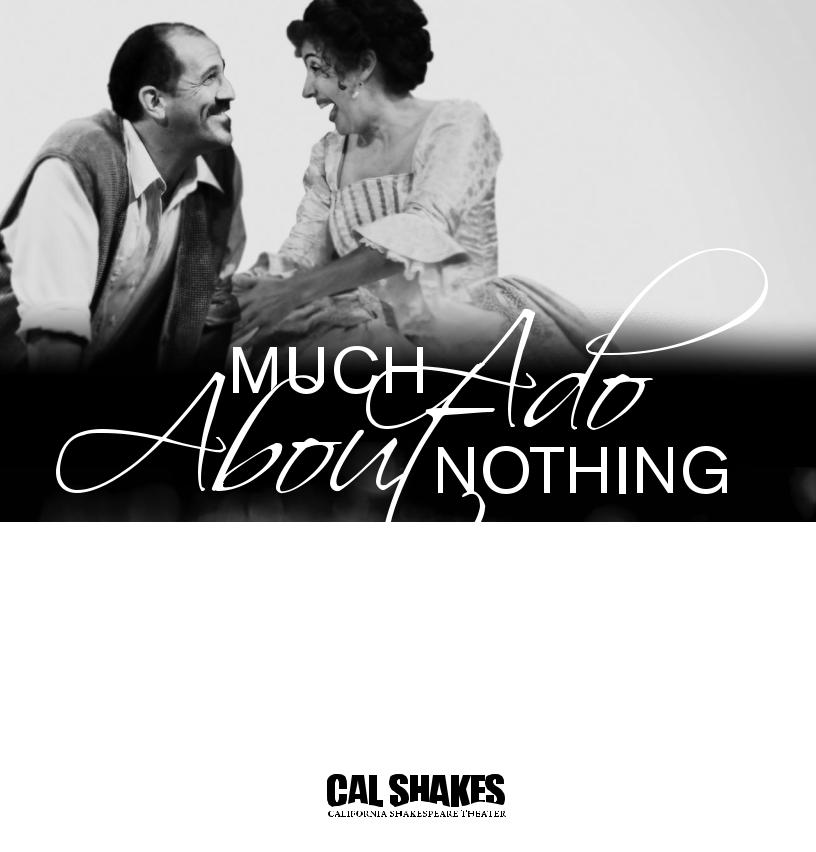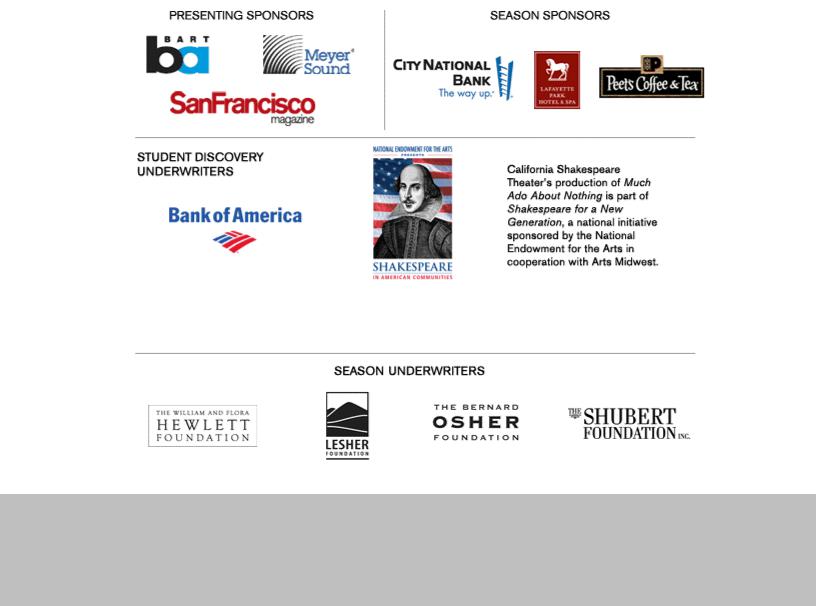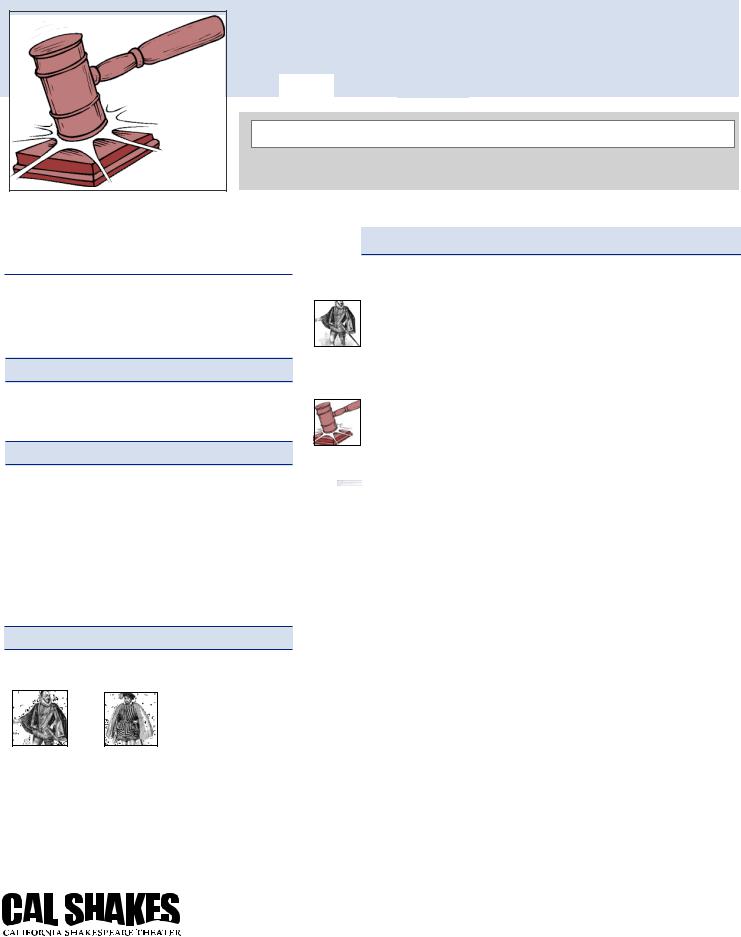
TeachersGuide_MuchAdoAboutNothing_2010
.pdf
WILLIAM SHAKESPEARE:
A MYSTERIOUS LIFE
William Shakespeare is considered one of the world’s finest playwrights in any time period. Writing in England in the late 1500s during the reigns of Queen Elizabeth I and King James1, he established himself as a major playwright, poet, and sometime actor. He mastered the comic and tragic dramatic
forms and introduced over 2,000 new vocabulary words into the English language. Shakespeare is read by nearly every American student. Some of his most well-known plays are Hamlet, Romeo and Juliet, and A Midsummer Night’s Dream.
Shakespeare’s life, however, is a constant source of debate and question in the scholarly community. Many records of the time that might have tracked his life or given more clues to how, when, and why he wrote his plays have been lost, if they even existed at all. Here are some of the facts and questions that people have raised based on the little we do know about his life.
•It has been usually assumed that Shakespeare was born on St George’s Day, April 23. But he was probably born on April 21, 22, or 23, 1564, given the 1559 prayer book’s instructions to parents on the subject of baptisms.
•From 1585 to 1592 the records of Shakespeare’s life are almost silent, and are commonly referred to the “lost years”. Biographers have put forth many imaginative stories about what Shakespeare was doing during this period:
-He helped his father in the family business (leathers and grains).
-He took a job as a law clerk.
-He worked as a schoolmaster.
-He worked as a scrivener (a person who copies out letters, deeds, et cetera)
-He travelled to Italy.
-He served as a soldier or sailor for an England threatened by Spain.
-He served a wealthy Catholic family in Lancashire, making Shakespeare likely a Catholic himself.
•There is no firm evidence of the roles Shakespeare acted or of the quality of his performances. Anecdotes ascribe to him various roles in his own plays, such as Adam in As You Like It and the Ghost in Hamlet, both smaller roles that suggest that perhaps Shakespeare was not that great an actor, needed more time for writing, or both.
•The play Sir Thomas Moore, never printed, survives in a manuscript written by a number of hands. It
is likely, though not absolutely certain, that Hand D, as it is known, is Shakespeare’s and that this is therefore the only piece of his handwriting—other than signatures—to survive.
•The biggest mystery of all is if the man known as William Shakespeare of Stratford-on-Avon, son of a glover, was really the author of all of the plays written under his name. A common argument is that a lower middle-class man such as himself would not have sufficient education or knowledge of court matters to write so insightfully and profoundly of the human condition and of kings, much less to use
language so skillfully. Some people even think that Queen Elizabeth herself might have written the plays!
•“Shakespeare” is not a particularly common or easy to spell name. Over the years there have been a number of variations in the spelling, as well as some ridiculous misspellings. But bear in mind that, back in Shakespeare’s day, there weren’t actually such things as standard spelling rules—people spelled words as they sounded. The most common spellings of Shakespeare include Shakespere, Shackspeare, and Shakspeare.
ELIZABETHAN CULTURE OVERVIEW |
- 21 - |

GO GIRLS!
“O God, that I were a man! I would eat his heart in the market-place.”
Beatrice, Act 4, scene 1
In Shakespeare’s time, the decision to marry was in the hands of a girl’s father: A father chose his daughter’s husband, and it was considered dishonorable and disrespectful of her to communicate her desires in the process. When a woman married, all of her personal property became the property of her husband, and she had no say in how it was spent. Women were regarded as chattel (property) to be married off to improve the family fortune or make political alliances. Elizabethans thought women needed a male caretaker (remember, females could not have careers). However, Shakespeare lived during the time of the Renaissance, which was a turbulent and exciting period of history in which many old and accepted ideas were being questioned, examined, and reinterpreted. Shakespeare is known for creating female characters that are just as complex, intelligent, and powerful as the males. Beatrice is one of the prime examples of this.
In Much Ado About Nothing, men expect to take the lead in most areas of social decisionmaking. Leonato has the power to decide when, who, and how Hero marries, and Claudio has the power to reject her at his will. Beatrice has to demand Benedick to challenge Claudio to a duel since she has never been allowed the training or experience to do so herself. It is men, in other words, who own all the choices. But Beatrice makes her choices in this play, through
her use of her intelligence and wit. She displays the verbal inventiveness that makes the kind of woman she is—unmarried, unparented—an acceptable reality in that society.
Just like Beatrice, Queen Elizabeth defied the expectations for women of her time. She never married because she realized early in her reign that marriage meant loss of power. Even though the general opinion of the time was that women’s minds were weak and that a female head of state was “an offense against nature”, she ruled with great political skill and cunning.
Hero, on the other hand, represents a very conventional woman of wealth of her time, barely speaking a word in the play, especially when compared to the other characters. By putting two such opposite kinds of women side-by-side in the play, Shakespeare reflects the changing world of his time.
For Students: What about Margaret?
There is uproar when it is suspected that Hero has had an affair. But when it is discovered that Margaret was mistaken for Hero, all is well. No one seems to be upset over Margaret’s behavior. Why? (Hint: Look at the rigid class structure of England at the time.)
ELIZABETHAN CULTURE OVERVIEW |
- 22 - |

RESOURCES
- 23 -

MUCH ADO ABOUT NOTHING
ON FILM
Much Ado About Nothing is a popular play onstage and even more popular on film. Many film versions exist that are directly named after the play; there are many more that employ vastly different interpretations or are simply inspired by the Much Ado story. Many of these films update the play to a modern setting. Here’s a few of the most popular:
Much Ado About Nothing (1913)
Directed by Phillips Smalley
Starring Pearl White and Chester Barnett
A silent short film based on the classic.
Much Ado About Nothing (1940)
Directed by Connie Rasinski
An animated short loosely based upon the Shakespeare’s plot.
Much Ado About Nothing (1962)
Directed by Joseph Papp
Starring Sam Waterston, Kathleen Widdoes, and Barnard Hughes
A stage production by the New York Shakespeare Festival on film, known for its complete use of the text.
Much Ado About Nothing (1967)
Directed by Alan Cooke
Starring Maggie Smith and Michael Byrne
Much Ado About Nothing (1993)
Directed by Kenneth Branagh
Starring Emma Thompson, Kenneth Branagh, Denzel Washington, Keanu Reeves, and Kate Beckinsale
RESOURCES - 24 -

ADDITIONAL RESOURCES:
BOOKS AND INTERNET
(page 1 of 2)
General Shakespeare Resources and Lesson Plans
Folger Shakespeare Library folger.edu
PBS’ “Shakespeare in the Classroom” pbs.org/shakespeare/educators/
The BBC’s “ShakespeaRe-told” bbc.co.uk/drama/shakespeare
“Tudor and Elizabethan Times” snaithprimary.eril.net/ttss.htm
“Life in Elizabethan England” elizabethan.org/compendium/
Shakespeare Resource Center’s “Elizabethan England” bardweb.net/england.html
The Kennedy Center’s “The Poetics of Hip Hop” artsedge.kennedy-center.org/content/3656/
Edutopia’s “Lights! Camera! Action! Public-Service Announcements: Violence Awareness” edutopia.org/pdfs/PA-ti-lessons/edutopia-romeo-and-juliet-psa.pdf
“Shakespearean Insult Worksheet” gallery.carnegiefoundation.org/collections/quest/collections/sites/divans-hutchinson_yvonne1/yvonne%20 scans/insultsheet.pdf
Teaching Resources for Much Ado About Nothing
Folger Education’s “Teaching Much Ado About Nothing” folger.edu/template.cfm?cid=2774
Folger Education’s Much Ado About Nothing lesson plans folger.edu/eduLesPlanArch.cfm#49
“Much Ado about Nothing - activities on the plot and character relationships” collaborativelearning.org/muchadoplotrelationships.pdf
The Stratford Festival’s Much Ado About Nothing animated version: stratfordfestival.ca/education/activities/muchado/06_animation/index.html
The BBC’s Much Ado About Nothing lesson plan for Upper-Intermediate to Advanced students teachingenglish.org.uk/try/lesson-plans/much-ado-about-nothing
Folger Shakespeare Library Education Department’s curriculum guide to Much Ado About Nothing series.simonandschuster.net/tagged_assets/cg14_859_3920.pdf
RESOURCES - 25 -

ADDITIONAL RESOURCES:
BOOKS AND INTERNET
(page 2 of 2)
Books
Davis, James E., ed. Teaching Shakespeare Today: Practical Approaches and Productive Strategies. Urbana, Ill: National Council of Teachers of English, 1993.
Crystal, David, and Crystal, Ben. The Shakespeare Miscellany. The Overlook Press, Peter Mayer Publishers, Inc. Woodstock and New York, 2005.
Crystal, David, and Crystal, Ben. Shakespeare’s Words: A Glossary and Language Companion. Penguin Books, The Penguin Group. London, 2002.
Papp, Joseph and Elizabeth Kirkland. Shakespeare Alive! New York, New York: Bantam Books, 1988.
Epstein, Norrie. The Friendly Shakespeare: A Thoroughly Painless Guide to the Best of the Bard. New York, New York: Penguin Books, 1993
Asimov, Isaac. Asimov’s Guide to Shakespeare. New York, New York: Random House, 1970.
Bender, Michael. All the World’s a Stage: a Pop-Up Biography of William Shakespeare.
San Francisco: Chronicle Books, 1999.
Foster, Cass and Lynn G. Johnson. Shakespeare: To Teach or Not To Teach. Grades 3 and Up. Scottsdale, AZ: Five Star Publications, 1992.
Garfield, Leon. Shakespeare Stories. Boston: Houghton Mifflin Company, 1998.
Morley, Jacqueline and John James. Shakespeare’s Theatre: the Inside Story. East Sussex, London: Simon and Schuster Young Books, 1994.
RESOURCES - 26 -

CLASSROOM |
Jonathan Moscone |
Artistic Director |
|
Susie Falk |
|
Managing Director |
|
Trish Tillman |
|
ACTIVITY GUIDE |
Director of Artistic Learning |
Emily Morrison |
|
Programs Manager |
|
Samantha Fryer |
|
September 2010 |
Artistic Learning |
Administration Manager |
|
|
|
|
|
NOTE TO TEACHERS: This guide was created as a supplement for teachers preparing students to see California Shakespeare Theater’s production of Much Ado About Nothing. Worksheets are designed to be used individually or in conjunction with others throughout the guide. While we realize that no aspect of this guide fully outlines a course for meeting a subject area standards, discussion questions and topics are devised to address certain aspects of California state standards. The activities here can be minimally reproduced for educational, non-profit use only. All lessons must be appropriately credited.
There are many excellent lesson plans for Much Ado About Nothing on the Internet. Please see our Resources page for links. This guide concentrates primarily on ideas that help students understand language, plot and character through activities that get students on their feet and speaking.
If you are interested in a California Shakespeare Theater Professional Development Workshop, which provides easy-to-learn tools for teachers to incorporate theater and arts education activities into California standardsbased core curriculum, please contact the Artistic Learning Administrations Manager at 510-548-3422 x105 or learn@calshakes.org.
- 27 -

CAL SHAKES’ MISSION
AND FUNDERS
OUR MISSION
We strive for everyone, regardless of age, circumstance, or background, to discover and express the relevance of Shakespeare and the classics in their lives by:
•making boldly imagined and deeply entertaining interpretations of Shakespeare and the classics.
•providing in-depth, far-reaching creative educational opportunities.
•bringing disparate communities together around the creation of new American plays inspired by classic literature.
OUR FUNDERS AND SPONSORS
Cal Shakes Artistic Learning programs are also supported by the Dale Family Fund, Dodge & Cox,
The Thomas J. Long Foundation, The San Francisco Foundation, and numerous individual donors.
California Shakespeare Theater
701 Heinz Avenue, Berkeley, CA 94710 - -
28
510.548.3422 • www.calshakes.org

SOCIAL NETWORKING CHARACTER STUDY:
“SHAKESBOOK”
Overview: Have your students create a Facebook profile like the following for a character from the play. Being able to empathize with fictional characters sheds light on our own personal situations, and recast the plot of the play in relevant terms.
Grades: 6–12
Goal: To bring the characters of Much Ado About Nothing into a real-world context.
State Standards: English Literary Response and Analysis 3.0-3.4
Outcomes: Students will be able to use basic facts from the text to imaginatively enter into the thoughts, feelings, and motivations of fictional characters by creating a mock Facebook page.
Activity: Familiarize students with the profile layout of a social networking site page such as Facebook. (See the following examples in parentheses.)
1.Ask the students to fill in the profile with
a.Vital statistics
b.Likes and dislikes
c.Friends
Note: Students should use information drawn from their knowledge of the play (Dogberry likes being in charge), filled out by their imaginations (when Dogberry was a teenager, he held mock trials of his schoolmates whenever they got in trouble with the teacher).
2.Profile photos may be drawn or cut out from magazines, or an actual photo of the student could be used and attached to the page. Remember, many actual Facebook profile pages do not have an actual photo of the person who made them—Facebook members sometimes choose a picture of something they feel represents them such as a tree, a poster they like, et cetera.
3.Share the pages you have created in student pairs or in a group discussion.
Reflection:
•Name one thing you had to imagine about your character that you think is really interesting.
•Was it easy to imagine beyond the play—for instance, what Don Pedro’s activities and interests might be? Or do you feel the play did not provide enough information? How so?
•How easy was it to decide who your character’s friends were? Would your character ignore a friend request from other characters in the play? Why or why not?
Extension exercise in writing dialogue:
Beyond the basic profile information, a further way to extend the activity is to have the students write on each other’s profile “walls”. A wall is the area on a profile page where friends can write short messages to each other that are posted directly on the page for others to view.
Note: Require the students to fill out the worksheet manually, rather than actually filling out a public profile online. If you can post the mock profile page that follows onto your school’s website or blog for students to fill out online within the framework of this project, that would work as well, but false profiles in a public space should be actively discouraged. Student examples should show a deep understanding of the plot and qualities of the character. Some examples follow.
ACTIVITY GUIDE - 29 -

shakesbook |
Much Ado About Nothing |
|
|
Dogberry
Wall Info Photos
Dogberry Remember that I am an ass!
Updated: 400 years ago |
Share |
|
|
“if I were as tedious as a king, I
could find it in my heart to bestow Wall it all of your worship”
Networks: Messina, Sicily
Sex: Male
Relationship Status: Single
Information
Email: dogberry@iamnotanass.net
Current city: Messina, Sicily
Likes & Interests
Interests: Making arrests, organizing the Prince’s Watch and fighting knavery.
Activities: Withholding the honor of the law, reprimanding the immorally weak, and generally keeping the disquiet.
Favorite TV Show: CSI, Judge Judy Favorite Music: Indiana Jones theme music
Friends
4 Friends See All
Verges Didn’t see any knaves today; will try again tomorrow.
Dogberry New episode of Judge Judy tonight! Such a suspectable woman! I have so much to learn from her.
Verges |
George Seacole |
|
|
ACTIVITY GUIDE - 30 -
